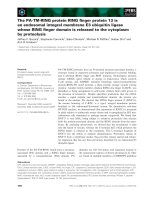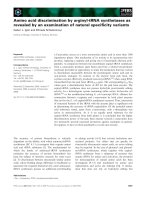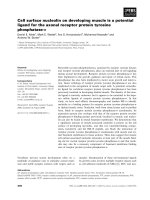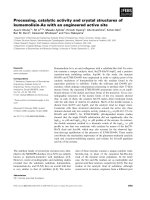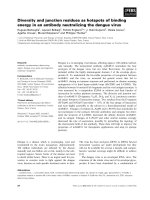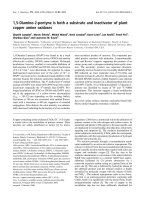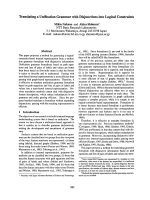báo cáo khoa học: " Translating clinicians'''' beliefs into implementation interventions (TRACII): A protocol for an intervention modeling experiment to change clinicians'''' intentions to implement evidence-based practice" pdf
Bạn đang xem bản rút gọn của tài liệu. Xem và tải ngay bản đầy đủ của tài liệu tại đây (248.02 KB, 6 trang )
BioMed Central
Page 1 of 6
(page number not for citation purposes)
Implementation Science
Open Access
Study protocol
Translating clinicians' beliefs into implementation interventions
(TRACII): A protocol for an intervention modeling experiment to
change clinicians' intentions to implement evidence-based practice
Martin P Eccles*
1
, Marie Johnston
2
, Susan Hrisos
1
, Jill Francis
3
,
Jeremy Grimshaw
4
, Nick Steen
1
and Eileen F Kaner
1
Address:
1
Centre for Health Services Research, University of Newcastle upon Tyne, 21 Claremont Place Newcastle upon Tyne NE2 4AA, UK,
2
School
of Psychology, College of Life Sciences and Medicine, William Guild Building, University of Aberdeen, Aberdeen, AB24 2UB, UK,
3
Health Services
Research Unit, Health Sciences Building, University of Aberdeen, Foresterhill, Aberdeen, AB25 2ZD, UK and
4
Clinical Epidemiology Program,
Ottawa Health Research Institute, University of Ottawa, 725 Parkdale Ave, Ottawa, ON K1Y 4E9, Canada
Email: Martin P Eccles* - ; Marie Johnston - ; Susan Hrisos - ;
Jill Francis - ; Jeremy Grimshaw - ; Nick Steen - ;
Eileen F Kaner -
* Corresponding author
Abstract
Background: Biomedical research constantly produces new findings, but these are not routinely incorporated
into health care practice. Currently, a range of interventions to promote the uptake of emerging evidence are
available. While their effectiveness has been tested in pragmatic trials, these do not form a basis from which to
generalise to routine care settings. Implementation research is the scientific study of methods to promote the
uptake of research findings, and hence to reduce inappropriate care. As clinical practice is a form of human
behaviour, theories of human behaviour that have proved to be useful in other settings offer a basis for developing
a scientific rationale for the choice of interventions.
Aims: The aims of this protocol are 1) to develop interventions to change beliefs that have already been identified
as antecedents to antibiotic prescribing for sore throats, and 2) to experimentally evaluate these interventions to
identify those that have the largest impact on behavioural intention and behavioural simulation.
Design: The clinical focus for this work will be the management of uncomplicated sore throat in general practice.
Symptoms of upper respiratory tract infections are common presenting features in primary care. They are
frequently treated with antibiotics, and research evidence is clear that antibiotic treatment offers little or no
benefit to otherwise healthy adult patients.
Reducing antibiotic prescribing in the community by the "prudent" use of antibiotics is seen as one way to slow
the rise in antibiotic resistance, and appears safe, at least in children. However, our understanding of how to do
this is limited.
Participants will be general medical practitioners. Two theory-based interventions will be designed to address the
discriminant beliefs in the prescribing of antibiotics for sore throat, using empirically derived resources. The
interventions will be evaluated in a 2 × 2 factorial randomised controlled trial delivered in a postal questionnaire
survey. Two outcome measures will be assessed: behavioural intention and behavioural simulation.
Published: 16 August 2007
Implementation Science 2007, 2:27 doi:10.1186/1748-5908-2-27
Received: 17 March 2006
Accepted: 16 August 2007
This article is available from: />© 2007 Eccles et al; licensee BioMed Central Ltd.
This is an Open Access article distributed under the terms of the Creative Commons Attribution License ( />),
which permits unrestricted use, distribution, and reproduction in any medium, provided the original work is properly cited.
Implementation Science 2007, 2:27 />Page 2 of 6
(page number not for citation purposes)
Background
The problem
Clinical and health services research is continually pro-
ducing new findings that may contribute to effective and
efficient patient care. However, despite the considerable
resources devoted to this area, a consistent observation is
that the transfer of research findings into practice is unpre-
dictable and can be a slow and haphazard process. This
phenomenon is apparent across different healthcare set-
tings, countries, and specialties, including the United
Kingdom (UK) [1-3], other parts of Europe [4], and the
United States of America (USA) [5-7], with obvious impli-
cations for patient care. Studies have been unable to
explain this variation in terms of either patient or resource
factors. Accepting that variation alone does not necessar-
ily represent inappropriate care, a small number of studies
have gone on to assess appropriateness [7] and conclude
that inappropriate care delivery was occurring.
Symptoms of upper respiratory tract infections (URTIs),
are common presenting features in primary care. They are
frequently treated with antibiotics, and rates of antibiotic
prescribing have been increasing in the UK [8]. However,
"the absolute benefits of using antibiotics in the treatment
of sore throat are modest. Protecting sore throat sufferers
against suppurative and non-suppurative complications
in modern Western society can be achieved only by treat-
ing with antibiotics many who will derive no benefit." [9].
Reducing antibiotic prescribing in the community by the
prudent use of antibiotics is seen as one way to slow the
rise in antibiotic resistance [10,11] and appears safe, at
least in children [12]. However, our understanding of
how best to achieve this is limited [13].
Implementation research
Implementation research is the scientific study of meth-
ods to promote the uptake of research findings, and hence
to reduce inappropriate care. It includes the study of influ-
ences on healthcare professionals' behaviour, and meth-
ods to enable them to use research findings more
effectively. Over the last decade, a considerable body of
implementation research has been reviewed [14-16]. This
research demonstrates that a range of interventions (e.g.,
reminder systems, interactive educational sessions) can be
effective in changing health care professionals' behaviour.
These studies have substantial heterogeneity within inter-
ventions used, targeted behaviours, and study settings that
make generalising their findings to routine healthcare set-
tings problematic. This is largely due to the absence of any
underlying generalisable framework for both research
studies and service settings by which to characterise indi-
viduals, settings, and interventions.
The interventions used are usually complex. The frame-
work for phases of investigation of complex interventions
suggested by the Medical Research Council (MRC) [17]
illustrates the current position with respect to implemen-
tation research. Table 1 compares the stages in the evalua-
tion of complex interventions to stages of drug evaluation.
To date, most implementation research studies have
involved exploratory trials (Phase II) or, more usually,
definitive randomized controlled trials (RCTs) (Phase III).
While the effectiveness of interventions varies across dif-
ferent clinical problems, contexts, and organizations [18],
studies provide scant theoretical or conceptual rationale
for their choice of intervention [19]. The current position
in the evaluation of implementation strategies is akin to
exploring the anti-anginal use of an antihypertensive drug
without any understanding of the pharmacodynamics of
the drug or the pathophysiology of angina or hyperten-
sion, and without Phase I trials of the pharmacodynamics
of the drug. Thus, this is an expensive version of trial-and-
error, with no a priori reason to expect success, nor confi-
dence in replicating success, if achieved.
To argue against the need for a better theoretical basis for
choosing implementation interventions, one would have
to suggest that every combination of setting, individ-
ual(s), and intervention is unique and must be examined
individually – this would require thousands of evalua-
tions and would incur prohibitive costs. The assumption
that clinical practice is a form of human behaviour and
can be described in terms of general theories relating to
human behaviour offers the basis for a generalisable
framework. Therefore, factors influencing the effective-
ness of interventions could include the beliefs of the
healthcare professional, or their perceived ability to con-
trol – generalisable concepts that can be used across differ-
ent interventions, settings, and individuals.
Using theory to develop implementation interventions:
conducting modeling experiments
In order to optimise the number of definitive RCTs studies
that will be both costly and time-consuming that need to
be conducted, and ensure their generalisability, it is neces-
sary to understand and optimise the 'active ingredients' in
professional behaviour change strategies and the charac-
teristics of the settings, targeted professionals, and behav-
iours that might modify the effectiveness of interventions.
Two approaches are necessary to achieve this. One is to
develop an understanding of the factors underlying pro-
fessional behaviour in order to identify what sorts of
empirical antecedents should be targeted in implementa-
tion interventions (equivalent to the theoretical phase of
the MRC Framework, and the subject of our previous
work [20]). The other is to develop an understanding of
how the elements of the interventions work and can there-
fore be optimised (the modeling and exploratory trial
phases of the MRC Framework).
Implementation Science 2007, 2:27 />Page 3 of 6
(page number not for citation purposes)
Almost all of the implementation interventions con-
ducted to date have selected interventions using intuitive/
non-theory analytical or empirically successful methods.
Three other methods (behavioural change technologies,
targeting theoretical antecedents, and targeting empirical
antecedents) have been much less developed in imple-
mentation research. However, if psychological theory is
going to contribute to effective implementation, then tar-
geting empirical antecedents and using behavioural tech-
nologies should be the optimum methods of selecting
interventions. There are three additional important issues
to consider: plausibility and feasibility (both in a develop-
ment experiment and in service settings), and the method
of delivery to maximise efficiency.
Work leading up to this protocol
Using psychological theory to identify salient beliefs that precede the
behaviour (empirical antecedents)
We have conducted a number of preliminary studies to
investigate the feasibility of using psychological theories
in implementation research, and their ability to identify
variables that might be targets for interventions. One of
these forms the basis of this protocol - a study using the
theory of planned behaviour to investigate factors associ-
ated with prescribing antibiotics for patients with uncom-
plicated sore throat by general practitioners (GPs) in
Grampian [21]. Literature reviews, non-participant obser-
vation, and interviews with GPs were used to develop
questionnaires that were distributed to a one in two ran-
dom sample of GPs in the region, achieving a 70%
response rate. Using the theory, we explored the relation-
ships between GPs' perceptions and the strength of their
intention to prescribe antibiotics. This allowed us to:
1. Identify whether GPs intended to prescribe antibiotics
or not. The majority indicated that they intended to pre-
scribe for less than half of patients presenting with
uncomplicated sore throat in the next two weeks.
2. Estimate the overall impact of individual beliefs and
perceptions on the strength of their motivation to pre-
scribe; potentially modifiable beliefs accounted for 48%
of the variance in GPs' intentions to prescribe.
3. Identify which beliefs had the biggest impact on inten-
tion to prescribe antibiotics.
4. Identify discriminant beliefs distinguishing GPs who
intended to prescribe from those who did not.
A methodology for developing and refining the design of interventions
We have piloted a methodology for developing and refin-
ing the design of interventions. In these intervention
modeling experiments (IMEs), elements of an interven-
tion are manipulated, within a randomised controlled
design, in a manner that simulates a real situation as
much as possible; interim endpoints (stated behavioural
intention) are measured rather than changes in profes-
sional behaviour or healthcare outcome. As such, these
studies sit within Modeling and Exploratory Trial Phases
of the MRC Framework (Table 1). They offer experimental
control and the opportunity to vary elements of an inter-
vention in order to better understand intervening varia-
bles and the effect on different outcomes. Compared to
large-scale trials, such experiments have potential
strengths in terms of their smaller size and shorter times-
cales.
For the method to be useful, interim endpoints must be
predictive of real world outcomes. This is the case for
behavioural intention, self-efficacy, and recall and under-
standing of information. Behavioural intention has been
incorporated into virtually all models of health behaviour
as the single best predictor of subsequent health behav-
iour [22]. The predictive ability of intention has been
demonstrated by reviews of both observational [23-25]
and experimental studies [26], with intention explaining
20% to 40% of variance in behaviour. Self-efficacy has
also been widely incorporated into models predicting
behaviour because of its reliable predictive effect [27]. In
interventions providing information, recall of that infor-
mation has been shown to be important to achieve behav-
iour change [28].
We have undertaken two pilot studies that demonstrate
the feasibility of the method [29,30]. In the first, we
designed an intervention to reduce the frequency of
extraction of third molar teeth by selecting the behaviour
change technique "generating alternative behaviours"
[29]. General dental practitioners (GDPs) were randomly
selected from the Scottish Dental Practice Board Register
and allocated to control or intervention groups, the latter
receiving a postal behavioural manipulation, and both
groups responding to a postal questionnaire. Subjects in
the intervention group were asked to generate a list of
management alternatives to third molar extraction prior
to being asked to record their third molar extraction inten-
tion, while subjects in the control group were not. The
intervention group had statistically significantly less
Table 1: Comparison of the stages in an evaluation of complex interventions to stages of drug evaluation.
Evaluation of drugs Pre-clinical Phase I Phase II Phase III Phase IV
Evaluation of implementation strategies Theory Modelling Exploratory trial Definitive RCT Long term implementation
Implementation Science 2007, 2:27 />Page 4 of 6
(page number not for citation purposes)
intention to extract third molars than the control group,
despite similar knowledge of management alternatives. In
the second, we simulated an empirically successful inter-
vention [30]. In this study, we investigated the effective-
ness of audit and feedback and educational reminder
messages in changing simulated x-ray test ordering by
GPs. Baseline rates of x-ray test ordering were established
in a postal survey based upon GPs' intentions to request
x-rays based upon patient vignettes. GPs were then sent
simulated results of any x-rays that they had requested. In
addition, they were randomised (within a 2 × 2 factorial
design) to receive or not 'audit & feedback' (comparative
group feedback generated from the first round responses)
or 'educational messages' on their x-ray result forms. Both
interventions were effective in changing behavioural
intentions.
This preliminary work forms the basis of the present pro-
tocol, the purpose of which is to use psychological theory
in the design and experimental evaluation of behavioural
interventions to change professional practice.
Aims of this protocol
The aims are 1) To develop interventions to change beliefs
that have already been identified as antecedents to antibi-
otic prescribing for sore throats, and 2) to experimentally
evaluate these interventions to identify those which have
the largest impact on behavioural intention and behav-
ioural simulation.
Methods
Clinical activity, setting, and participants
We will use the management of uncomplicated sore
throat in general practice as the clinical focus for this
work. Participants will be general medical practitioners.
Design
Two interventions will be developed to address the discri-
minant beliefs in the prescribing of antibiotics for sore
throat. Appropriate intervention components will be
selected from a number of available evidence-based
behavioural technologies. The design of the interventions
will incorporate these techniques and will be further
informed by the empirical findings of our previous stud-
ies. The interventions will be evaluated in a 2 × 2 factorial
randomised controlled trial delivered in a postal ques-
tionnaire survey.
Interventions
Our previous work [21] has identified eight discriminant
beliefs that distinguish between GPs who do (intenders)
and do not intend (non-intenders) to prescribe antibiotics
for patients with uncomplicated sore throat (Table 2). We
will make the assumption that altering these beliefs will
change intentions to manage URTI without prescribing
antibiotics, and we will therefore design the interventions
to change these beliefs. Therefore, it will be possible to test
the assumption empirically by applying a mediational
analysis to explain intervention effects. Two theory-based
interventions that incorporate behaviour change technol-
ogies will be designed to promote the management of
URTI presenting in primary care without prescribing anti-
biotics.
Outcome measurement
Two outcome measures will be assessed, behavioural
intention and behavioural simulation. We will measure
behavioural intention using the standard methods used in
investigations based on the theory of planned behaviour
using rating scales of likelihood, frequency, or agreement
with statements or questions about intention (e.g. Out of
the next 10 patients you see with acute sore throat, how
many do you intend to prescribe antibiotics for? Score 0 –
10). To measure behavioural simulation, participants will
be asked to respond to written scenarios describing
patients presenting with sore throat in general practice.
The scenarios will reflect the range of patients and clinical
features that present in general practice informed by qual-
itative work conducted in our previous work [21]. Partici-
pants will be asked to write on a simulated set of notes the
relevant management they would use.
Table 2: Discriminant beliefs that distinguish between GPs who do (intenders) and do not intend (non-intenders) to prescribe
antibiotics for patients with uncomplicated sore throat.
Behavioural beliefs
Prescribing an antibiotic for these patients will reduce their risk of developing minor complications such as otitis media and sinusitis
Prescribing an antibiotic for these patients is cost efficient
Prescribing an antibiotic for these patients will reduce the time taken for their sore throat to resolve
Outcome evaluation
The problems of antibiotic resistance for these patients does not concern me greatly
Control beliefs
If a patient asks for an antibiotic, then I will prescribe one whether it is medically indicated or not
I am more inclined to prescribe an antibiotic for patients of a lower social class
Because I don't know the cause of these patients' sore throats, I will prescribe an antibiotic so that I don't miss something
In most cases, the patient will finish the course of antibiotics I prescribe
Implementation Science 2007, 2:27 />Page 5 of 6
(page number not for citation purposes)
Process measurement
We will examine whether the interventions affect the dis-
criminant antecedents identified in the previous theory of
planned behaviour study (Table 2). We have piloted these
methods successfully [29,31]. The results will be explored
using the Baron and Kenny methodology for mediational
analyses [32], which incorporates the Sobel test, to ascer-
tain the extent to which these antecedent beliefs mediated
effects on outcomes within these experiments. Where pos-
sible, the measurement will be made twice, with these
process measures assessed both before and following the
intervention. The time between measurements will be six
to eight weeks.
Delivering the modeling experiment
The experimental materials will be delivered by post. The
experiment will be embedded within a questionnaire sur-
vey which will be administered twice, once before the
intervention and once immediately following the inter-
vention. Based on our previous experience, we plan that
subjects will receive a letter of invitation, a set of instruc-
tions, and individually packaged set of materials for meas-
uring behavioural simulation and intention that they will
be asked to read in this order. On the second administra-
tion of the survey, they will also receive the intervention
which they will be asked to complete prior to completing
the process and outcome measures. Two reminders will be
mailed to non-responding clinicians. Given our experi-
ence of the response rate in our previous study [31], we
plan to offer a £10 incentive to each subject to increase
response rates [33,34].
Sample size and analysis
In a 'definitive trial', there is inherent variability in the
number of patients who consult with each condition, and
the characteristics of these patients vary from doctor to
doctor and from year to year. By giving all subjects in the
experiment the same context in which to examine behav-
ioural intention, we have eliminated these two sources of
variation. Therefore, if we use the same outcome in both
the trial and in the IME, we would expect its standard devi-
ation to be smaller in the IME than in the trial. Thus, a
given shift in outcome (difference between two groups)
represents a much larger effect size (difference in outcome
divided by the standard deviation) in the IME than in the
trial. Thus, if a trial were to produce a moderate effect size
we might expect a large effect size in the IME. The IME will
be powered to detect difference between each of the active
intervention groups and the control group. Using stand-
ard methods for a continuous outcome, we need 50 sub-
jects per group to have 80% power of detecting an effect
size of 0.8 using a significance level of 2.5%, giving a total
sample size of 200 for the experiment. We will over-sam-
ple, using an initial sample of 800, to ensure that we
achieve this final sample size. This will be adjusted in the
light of the impact of the incentive. Groups will be com-
pared using methods appropriate for comparing inde-
pendent samples (t-tests to compare two groups, analysis
of covariance to compare groups adjusting for differences
in baseline performance).
Ethics approval
The study has ethical approval from the Northern and
Yorkshire Multi-Centre Research Ethics committee. (REC
Reference: 05/MRE03/11).
Competing interests
The author(s) declare that they have no competing inter-
ests.
Authors' contributions
All authors contributed to the conception and design of
the study and approved the submitted draft.
Acknowledgements
This study is funded by the European Commission Research Directorate as
part of a multi-partner program: Research Based Education and Quality
Improvement (ReBEQI): A Framework and tools to develop effective qual-
ity improvement programs in European healthcare. (Proposal No: QLRT-
2001-00657). Jeremy Grimshaw holds a Canada Research Chair in Health
Knowledge Transfer and Uptake.
References
1. Smith WCS, Lee AJ, Crombie IK, Tunstall-Pedoe H: Control of
blood pressure in Scotland: the rule of halves. BMJ 1990,
300(6730):981-983.
2. Eccles M, Bradshaw C: Use of secondary prophylaxis against
myocardial infarction in the North of England. BMJ 1991,
302(6768):91-92.
3. Ketley D, Woods KL: Impact of clinical trials on clinical prac-
tice: example of thrombolysis for acute myocardial infarc-
tion. Lancet 1993, 342:891-894.
4. Woods KL, Ketley D, Lowy A, Agusti A, Hagn C, Kala R, Karatzas NB,
Leizorowicz A, Reikvam A, Schilling J, Seabra-Gomes R, Vasiliauskas
D, Wilhelmsen L: Beta-blockers and antithrombotic treatment
for secondary prevention after acute myocardial infarction.
Eur Heart J 1998, 19:74-79.
5. Chassin MR, Brook RH, Park RE, Keesey J, Fink A, Kosecoff J, Kahn
K, Merrick N, Solomon DH: Variations in the use of medical and
surgical services by the Medicare population. N Engl J Med
1986, 314(5):285-290.
6. Lee AJ, Huber JH, Stason WB: Factors contributing to practice
variation in post-stroke rehabilitation. Health Serv Res 1997,
32(2):197-221.
7. Winslow CM, Solomon DH, Chassin MR, Kosecoff J, Merrick NJ,
Brook RH: The appropriateness of carotid endarterectomy.
N Engl J Med 1998, 318(12):721-727.
8. Davey P, Bax R, Newey J, al E: Growth in the use of antibiotics in
the community in England and Scotland in 1980-1993. BMJ
1996, 312:613.
9. Del Mar CB, Glasziou PP, Spinks AB: Antiobiotics for sore throat.
The Cochrane Library 2004.
10. Standing medical advisory committee subgroup on antimicrobial
resistance: The path of least resistance. London: Department of
Health; 1998.
11. Seppala H, Klaukka T, Vuopio-Varkila J: The effect of changes in
the consumption of macrolide antibiotics on erythromycin
resistance in group A streptococci in Finland. Finnish Study
Group for Antimicrobial Resistance. N Engl J Med 1997,
337(441):446.
12. Sharland M, Kendall H, Yeates D, Randall A, Hughes G, Glasziou P,
Mant D: Antiobiotic prescribing in general practice and hos-
Publish with BioMed Central and every
scientist can read your work free of charge
"BioMed Central will be the most significant development for
disseminating the results of biomedical research in our lifetime."
Sir Paul Nurse, Cancer Research UK
Your research papers will be:
available free of charge to the entire biomedical community
peer reviewed and published immediately upon acceptance
cited in PubMed and archived on PubMed Central
yours — you keep the copyright
Submit your manuscript here:
/>BioMedcentral
Implementation Science 2007, 2:27 />Page 6 of 6
(page number not for citation purposes)
pital admissions for peritonsillar abscess, mastoiditis, and
rheumatic fever in children: time trend analysis. BMJ 2005,
331:328-329.
13. Little P: Delayed prescribing of antibiotics for upper respira-
tory tract infection. BMJ 2005, 331:301-302.
14. Bero L, Grilli R, Grimshaw JM, Harvey E, Oxman AD, Thomson MA:
Closing the gap between research and practice: an overview
of systematic reviews of interventions to promote the imple-
mentation of research findings. The Cochrane Effective
Practice and Organization of Care Review Group. BMJ 1998,
317:465-468.
15. Oxman AD, Thomson MA, Davis DA, Haynes B: No magic bullets:
a systematic review of 102 trials of interventions to improve
professional practice. Can Med Assoc J 1995, 153(10):1423-1431.
16. Grimshaw JM, Shirran L, Thomas RE, Mowatt G, Fraser C, Bero L,
Grilli R, Harvey EL, Oxman AD, O'Brien MA: Changing provider
behaviour: an overview of systematic reviews of interven-
tions. Med Care 2001, 39(Suppl 2):II2-II45.
17. Medical Research Council: A framework for development and
evaluation of RCTs for complex interventions to improve
health. 2000.
18. Grimshaw J, Thomas RE, Maclennan G, Fraser C, Ramsay C, Vale L,
Whitty P, Eccles M, Matowe L, Shirren L, Wensing M, Dijkstra R,
Donaldson C: Effectiveness and efficiency of guideline dissem-
ination and implementation strategies. Health Technol Assess
2004, 8(6):.
19. Davies P, Walker A, Grimshaw J: Theories of behaviour change
in studies of guideline implementation. Proceedings of the British
Psychological Society 2003, 11(1):120.
20. Walker A, Grimshaw JM, Johnston M, Pitts N, Steen N, Eccles MP:
PRocess modelling in ImpleMEntation research:selecting a
theoretical basis for interventions to change clinical prac-
tice. BMC Health Services Research 2003, 3:22.
21. Walker AE, Grimshaw JM, Armstrong E: Salient beliefs and inten-
tions to prescribe antiobiotics for patients with a sore
throat. British Journal of Health Psychology 2001, 6:347-360.
22. Predicting health behaviour. Edited by: Conner M, Norman P.
Buckingham , Open University Press; 1996.
23. Godin G, Kok R: The theory of planned behaviour: a review of
its applications to health-related behaviours. American Journal
of Health Promotion 1996, 11(2):87-98.
24. Armitage CJ, Conner M: Efficacy of the theory of planned behav-
iour: a meta-analytic review. British Journal of Social Psychology
2001, 40:471-499.
25. Sheeran P: Intention-behavior relations: A conceptual and
empirical review. In European Review of Social Psychology Volume 12.
Issue 1 Edited by: Stroebe W, Hewstone M. John Wiley & Sons Ltd.;
2002:1-36.
26. Webb TL, Sheeran P: Does Changing Behavioural Intention
Engender Behaviour Change? A Meta-analysis of the Experi-
mental Evidence. Psychol Bull 2006, 132(2):249-268.
27. Bandura A: Self-efficacy: the exercise of control. New York ,
Freeman; 1997.
28. Ley P: Communicating with patients: improving communica-
tion, satisfaction and compliance. London , Chapman Hall; 1988.
29. Bonetti D, Johnston M, Pitts N, Deery C, Ricketts I, Bahrami M, Ram-
say C, Johnston J: Can psychological models bridge the gap
between clinical guidelines and clinicians' behaviour? Aran-
domised controlled trial of an intervention to influence den-
tists' intention to implement evidence-based practice. British
Journal of Dentistry 2003, 195(7):403-407.
30. Bonetti D, Eccles M, Johnston M, Steen IN, Grimshaw J, Baker R,
Walker A, Pitts N: Guiding the design and selection of inter-
ventions to influence the implementation of evidence-based
practice: an experimental simulation of a complex interven-
tion trial. Soc Sci Med 2005, 60(9):2135-2147.
31. Eccles M, Steen N, Grimshaw J, Thomas L, McNamee P, Soutter J,
Wilsdon J, Matowe L, Needham G, Gilbert F, Bond S: Effect of audit
and feedback, and reminder messages on primary-care radi-
ology referrals: a randomised trial. Lancet 2001, 357:1406-1409.
32. Baron RM, Kenny DA: The moderator-mediator variable dis-
tinction in social psychological research: conceptual, strate-
gic, and statistical considerations. J Pers Soc Psychol 1986,
51(6):1173-1182.
33. McColl EM, Jacoby A, Thomas L, Soutter J, Bamford C, Steen IN, Tho-
mas R, Harvey E, Garrett A, Bond J:
Design and use of question-
naires: a review of best practice applicable to surveys of
health service staff and patients. Health Technol Assess 2001,
5(31):1-256.
34. Halpern SD, Ubel PA, Berlin JA, Asch DA: Randomized trial of $5
versus $10 monetary incentives, envelope size, and candy to
increase physician response rates to mailed questionnaires.
Med Care 2002, 40(9):834-839.
